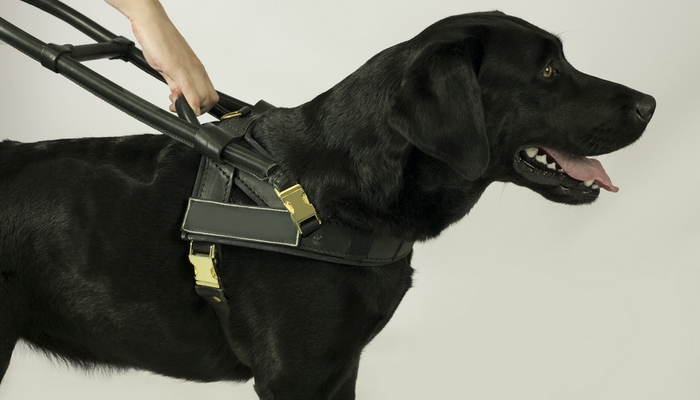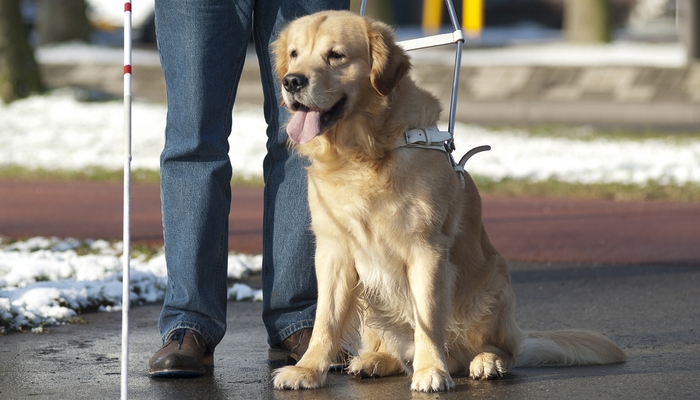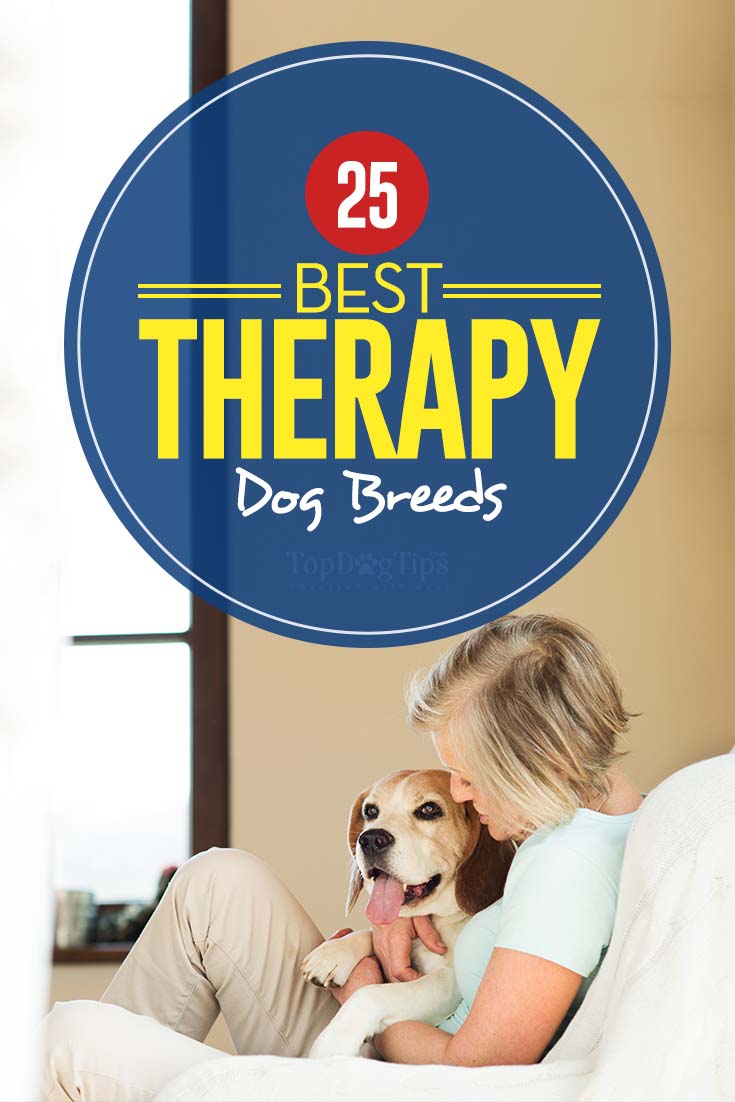
KEY TAKEAWAYS:
- Therapy dogs can give a calming presence to places where tension, stress, and anxiety is high, like schools, nursing homes, etc.
- Therapy dogs and Service dogs have slight differences in how they assist humans.
- The breed is not the main determiner of whether a dog would be the best therapy dog; it's their personality and training.
Table of Contents
- Dogs For Therapy? What Makes Them Good At It?
- The 25 Best Therapy Dog Breeds List
- The Best Dog Breeds for Therapy Dogs
- The Difference Between Therapy Dogs and Service Dogs
- Common Questions About the Best Therapy Dog Breeds
- Best Therapy Dog Breeds: Take Your Pick!
Are you looking for the Best Therapy Dog Breed to help you get through life right now?
I get you.
After all, sometimes, we just really need a “best friend” and a “shoulder to cry on.”
And sometimes, the purest of love can be in the form of a wet nose and gentle paws!
The effects of animal therapy on stress reduction and emotional well-being are strong but need to be well documented in unbiased scientific literature to help support a professional approach to the field.
-Judy McPherson, Founder & President, The Good Dog Foundation
Many academic research and clinical studies have proven again and again how dogs make humans feel good.
Somehow, these furry little fellas have hijacked our happy hormones to make us feel loved just by looking at us with those big, expressive eyes.
In fact, one study that The Good Foundation participated in found that:
The study spotlighted two important findings: (1) dogs, all by themselves, can improve children’s mood and ability to cope with anxiety, and (2) they can do so as a therapeutic intervention for stress recovery. This is the first study to look at the impact of dogs on stress recovery in children.
But aren't therapy dogs only for the visually impaired?
Nope.
Those are service dogs!
Okay… What's the difference?
Patience. We'll get to that later.
Anyway, regardless of your reason (hey, we don't judge here,) we have compiled a list of the best therapy dog breeds you can choose from.
But before we get to that, first, let's talk about what makes a good therapy dog.
Dogs For Therapy? What Makes Them Good At It?
Actually, there is more to making a great therapy dog than breed alone.
In fact, many therapy and service dogs are mixed breeds that have been rescued from shelters.
In the US, therapy dogs are never considered service animals and are not granted the same privileges, according to ADATA.
However, some places worldwide can credit them as such anyway.
This depends on what country you're in.
To get a dog certified as a therapy dog, your canine will need to pass a certification.
In the US, for example, your dog must get AKC's Canine Good Citizen certification (a program established in 1989).
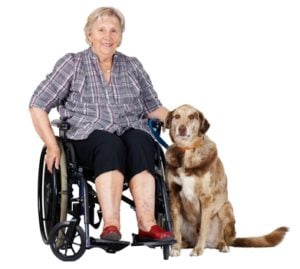 The ingredients that make a great therapy dog are personality and training.
The ingredients that make a great therapy dog are personality and training.
Dogs that are trained to be therapy dogs must master obedience training, social training, and pack leader training.
Any canine that is skittish, aggressive, fearful, willful, or stubborn will not make the cut.
What Are the Traits of a Good Therapy Dog?
You'll notice that any of the dog breeds we have listed below share similar traits.
Personality, energy levels, and overall characteristics are commonly related to breeds.
So it just makes sense that we look at the breeds in general!
However, any dog breed can become a therapy dog as long as she has the following personality traits:
Calm
Therapy dogs can have higher energy levels, but only if they know how to save that energy for non-therapeutic times.
They must be able to sit and stay calm for a long time.
Clean
A good therapy dog will be clean since they commonly go into areas with vulnerable populations, like nursing homes.
This means that you will have to keep them well-groomed.
It also means the best choices shed and drool less.
Focused
Therapy dogs frequently have to work in loud environments with a lot of distractions.
Because of this, it can be hard to focus on the patient, but therapy dogs must be able to do that.
Gentle
Gentleness somewhat goes hand-in-hand with calmness.
Essentially, dogs must be aware of what is too much for the average person.
They need to be aware of their strength and know not to use it all.
This is especially important for bigger breeds.
Highly-Trained
Among the most important traits of a therapy dog is being well-trained.
They need to listen when called to sit or stay.
Overall, they need to be controllable in varying situations.
It helps if they can also complete basic tasks or help people with those tasks.
As a bonus, trained dogs tend to learn new commands quickly.
Intelligent
Therapy dogs have to be smart for several reasons.
This helps with training and allows them to tell if someone they are helping would rather play or be calm.
Essentially, intelligence helps them adapt to changing situations.
Sociable
It should go without saying that the ideal therapy dog will be sociable.
They will spend time with a lot of people and need to make new friends quickly.
Touchable
Therapy dogs should be fine with people touching them nearly anywhere.
RECOMMENDED: Science On Therapy Dogs for Depression – Fact or Fiction?
Types of Therapy Dogs
Just one more pit stop before we get on the list.
There are two main categories of therapy dogs that a pup can fit into.
Therapeutic Visitation Dogs
These dogs are usually someone’s pet that has been trained and certified as a companion.
They often visit nursing homes, hospitals, schools, and other places to socialize with patients or students.
Think of them as part-time calm-provider to the people who needs them.
Animal-Assisted Therapy Dogs
These pups, on the other hand, typically spend their time in a specific institution.
They commonly go beyond providing just emotional support.
Animal-assisted therapy dogs also complete simple tasks, such as helping patients walk or do other activities.
Overall, interacting with therapy dogs can help people:
- Socialize
- Help develop social skills
- Improve participation in therapy
- Have a better mood
- Improve comfort levels
- Reduce depression and anxiety
Now that we got some things sorted out, let's proceed to our list!
The 25 Best Therapy Dog Breeds List
They're all good boys and girls; we know that.
But the reality is not all dog is capable of the discipline and work needed to become therapy dog.
So without further ado, let's dive into the best therapy dog breeds list we've ranked for you!
Small Therapy Dogs Breeds
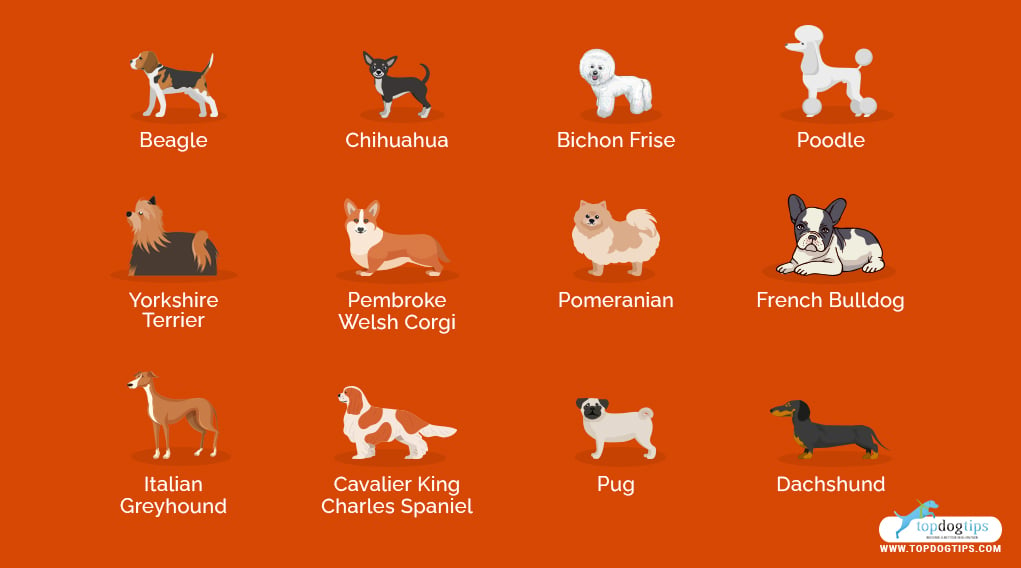
1 . Beagle
. Beagle
Portable and friendly, this much-loved scent hound makes a great therapy dog.
Especially in situations where the best smeller wins, such as for blood sugar detection.
Great with kids, this is an excellent service dog for large households or a therapy dog for children’s hospitals.
Beagles are independent, though, and some won’t accept training well enough to make the cut.
2. Chihuahua
 The small size of this breed makes them ideal for a therapy dog that does a lot of traveling.
The small size of this breed makes them ideal for a therapy dog that does a lot of traveling.
Of course, if you need one to fetch large items, this tiny pooch won’t be up to the job.
Easy to groom and bathe, this dog won’t require trips to a professional groomer.
Chihuahuas are usually friendly and confident.
These fur babies love people.
They can be loud or destructive if left alone for too long.
3. Bichon Frise
 A companion breed, dogs in this class do not shed.
A companion breed, dogs in this class do not shed.
This makes them great for therapy dogs – no hair left behind in restaurants, stores, hospitals, or homes.
Bichon Frises are happy, cheerful, and playful.
They are sure to bring a smile to everyone they meet.
These pooches are not always good around kids and other pets.
They need to receive proper socialization training.
4. Poodle
The Poodle actually comes in three sizes – small, medium, and large.
Their intelligence and intuitive demeanor make them ideal therapy dogs.
Intuitive and adaptive, dogs in this breed can act predictably and appropriately in any situation.
The Poodle has a long coat that will need regular clipping and grooming.
They are also prone to weight gain.
5. Yorkshire Terrier
 Brave and curious, these little dynamites are up for anything.
Brave and curious, these little dynamites are up for anything.
But you probably didn't expect to see them on the best therapy dog breeds list.
They love to be needed, so they are great for getting medications in an emergency or pushing that alert button.
These small dogs are great therapy dogs for hospitals, nursing homes, and schools.
Their size makes them very easy to handle.
Yorkies can be strong-willed and aggressive.
They need a strong trainer that trains in social skills and obedience.
6. Pembroke Welsh Corgi
 Bred for working, these pups have the right personality and instinct to serve.
Bred for working, these pups have the right personality and instinct to serve.
Hey, if they are good enough for The Queen, they are good enough for me.
With intelligence and friendliness, the Pembroke Welsh Corgi has what it takes to be a service and therapy dog.
These canines are energetic, so if they need to serve, they will be exercised and kept busy.
7. Pomeranian
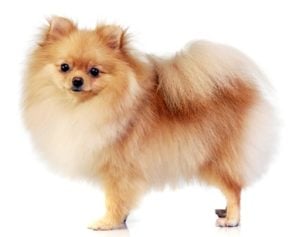 With low energy and little exercise needs, the “Pom” is great for home-bound patients, as well as situations that require a quiet, calm animal.
With low energy and little exercise needs, the “Pom” is great for home-bound patients, as well as situations that require a quiet, calm animal.
The best thing about these dogs, in my opinion, is that they are not destructive.
They also need very little exercise.
To be a therapy dog, this breed needs socialization training from puppyhood.
They are often standoffish.
INTERESTING READ: Netflix’s ‘Queen Charlotte' Pomeranian Obsession, Inspired by Real Events?
8. French Bulldog
These lap dogs are absolutely great for companionship and people's mental and physical health.
French Bulldogs want nothing more than to be petted, loved, and reassured.
Loving, playful, and adaptable, you will be hard-pressed to find anything that DOESN’T make this fur baby a great therapy dog.
Independent and stubborn, the Frenchie needs to begin training as soon as possible.
9. Italian Greyhound
 If you are looking for a fur baby that is sensitive and alert, look no further.
If you are looking for a fur baby that is sensitive and alert, look no further.
These characteristics make Italian Greyhounds great for being a guide dog or any other therapy dog.
These sensitive dogs are alert and playful.
Great for making the rounds in institutions, these dogs are energetic.
These sleek hounds do not do well in cold temperatures.
As a sighthound, they are also quick to chase if not properly trained.
10. Cavalier King Charles Spaniel
Cute and cuddly, these pooches are ready to cheer up the sick and put a smile on everyone’s face.
These obedient canines love to please, making them easy to train.
With a sweet face and gentle disposition, the Cavalier was made for work as a therapy dog.
You must use sensitive training to keep these fur babies from becoming fearful and timid.
11. Pug
 Another pup that is certainly often included on many best therapy dog breeds lists, this canine loves people and attention.
Another pup that is certainly often included on many best therapy dog breeds lists, this canine loves people and attention.
Pug owners say these clowns bring a lot of entertainment into any situation.
These outgoing dogs are cheerful and curious.
They are known to be even-tempered, which makes them predictable and trainable.
The facial structures of these dogs make them snort and snore most of the time.
Also, care must be taken to keep them from overheating.
ALSO READ: Best Care for Flat-Faced Dog Breeds: Care Tips for Brachycephalic Pups
12. Dachshund
This playful breed is great at lifting spirits and encouraging exercise.
They are great for people with anxiety and depression.
If you ask people one word that describes a Dachshund, many will say “spunky.”
They are lively and curious.
With long spines and short legs, it is not healthy for one of these pooches to climb stairs or play jumping games.
SIMILAR: How To Get A Service Dog for Anxiety and Depression & the Costs of It
Large Therapy Dogs Breeds
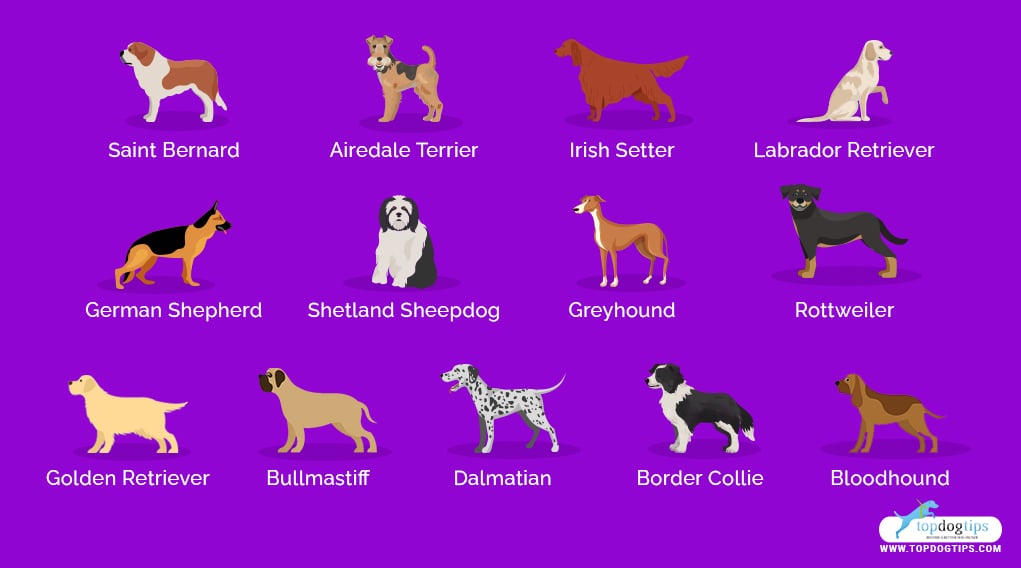
13. Saint Bernard
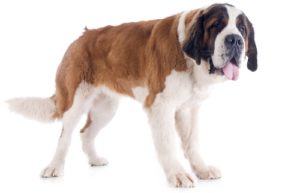 These large dogs were bred to help and still enjoy their duties today.
These large dogs were bred to help and still enjoy their duties today.
With a history of rescuing stranded travelers in Saint Bernard Pass, they're quite naturally good therapy dog breeds.
Like many dogs on this best therapy dog breed list, Saint Bernards are friendly and affectionate.
These fur babies do not need a lot of exercise.
And as you may know—this breed is incredibly huge.
They need space to stretch out.
Shedders and droolers, they require quite a bit of maintenance.
14. Airedale Terrier
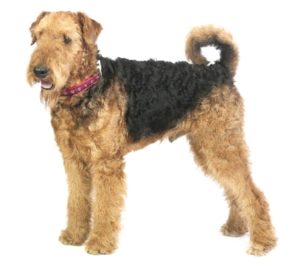 Needing a lot of exercise, these elegant pups are great as guide dogs for the visually impaired.
Needing a lot of exercise, these elegant pups are great as guide dogs for the visually impaired.
Airedale Terriers are also large enough to fetch anything their owner needs.
Rugged and tough, these pups can survive in almost any condition.
Their short hair is attractive and easy to maintain.
This breed is truly a dog’s dog.
They love dog activities like barking, digging, and chewing.
ALSO READ: How to Stop a Dog from Digging
15. Irish Setter
 With graceful strides and silky hair, the Irish Setter is ready to stroll into the hearts of many.
With graceful strides and silky hair, the Irish Setter is ready to stroll into the hearts of many.
This friendly breed loves being around lots of people and getting lots of attention.
Affectionate, intelligent, and easy to train, dogs in this breed make excellent therapy and service dogs.
Active and energetic, the Irish Setter does not do well living in apartments.
They need room to roam and stay busy.
16. Labrador Retriever
Traditionally hunting dogs, Labs take to training easily.
Their size and strength make them great for fetching things.
All this, and a friendly attitude, make this one of the top contenders on the best therapy dog breeds list.
With a desire to please, these pooches make great service dogs.
Friendly and gregarious, Labs do well with everyone.
These dogs need obedience training starting early.
They are so playful and energetic that they can accidentally hurt someone.
17. German Shepherd
 These canines have a reputation for being reserved around strangers.
These canines have a reputation for being reserved around strangers.
They don’t get distracted easily, so they are great for intense work like guiding and listening.
Calm and restrained, these dogs have the attitude needed to be serious work dogs.
Despite this, they can also be loving and playful.
German Shepherds need socialization training to avoid becoming aggressive.
These dogs can be destructive when bored.
ALSO READ: Destructive Chewing: Why Dogs Love to Gnaw and How to Stop This
18. Shetland Sheepdog
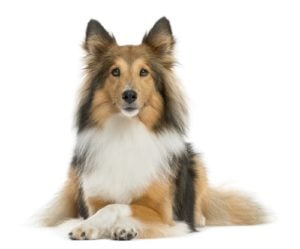 Beautiful and bold, the “Miniature Collie” is one of the smartest dogs in the world.
Beautiful and bold, the “Miniature Collie” is one of the smartest dogs in the world.
These friendly dogs are healthy and devoted.
Shetland Sheepdogs usually love everyone they meet.
However, the long, luxurious coat on these pooches gets easily matted.
They require extensive brushing and grooming.
19. Greyhound
 A traditional racing dog, Greyhounds know how to be calm in crowds.
A traditional racing dog, Greyhounds know how to be calm in crowds.
They're also easy to train and excel in agility.
This breeding gives them everything they need to perform tasks for disabled owners.
Friendly and calm, the Greyhound is great around children and other animals.
Although they are calm in attitude, they still have the energy to work overtime.
These fur babies are jumpers.
Make sure you have a high fence in the areas where they are not on a leash.
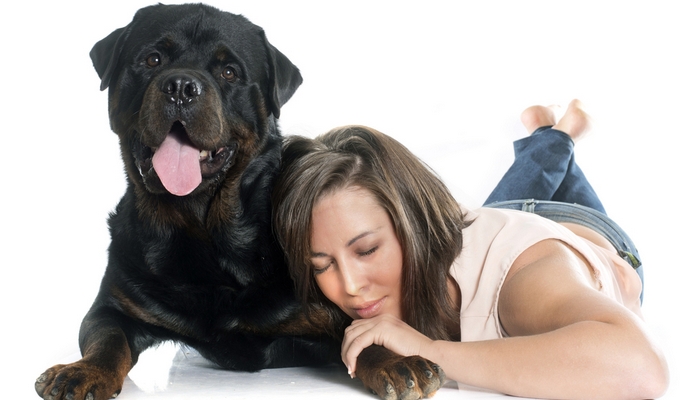 20. Rottweiler
20. Rottweiler
This stigmatized breed is usually not thought of as a therapy dog.
They're mostly assumed to be police dogs, search and rescue dogs, and guide dogs.
Rottweilers are calm, loyal, and brave.
They are friendly and gentle unless trained to be otherwise.
These dogs are massive.
They need obedience training and socialization training starting as early as possible.
21. Golden Retriever
 These canines are gentle, friendly, and devoted.
These canines are gentle, friendly, and devoted.
Everything a canine on the best therapy dog breeds list should be.
Golden Retrievers are also intelligent and easy to train.
These popular dogs are loving and willing to please.
With devotion and kindness, they make great service dogs.
Traditional hunting breeds like these need room to roam and ways to work off their excess energy.
INTERESTING READ: Golden Retriever Travels 40 Miles for 27 Days to Return to His Original Family
22. Bullmastiff
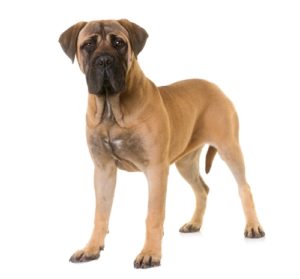 You may be surprised to find the Bullmastiff on the best therapy dog breeds list due to their extra-large size.
You may be surprised to find the Bullmastiff on the best therapy dog breeds list due to their extra-large size.
These gentle giants have what it takes to be a volunteer.
Patient and kind, their physical and emotional strength make them great servers in the community.
This working breed still loves to work and is happy doing whatever you need.
They are easy to groom and shed little. Reserved with strangers, trainers need to start socialization early to avoid aggression.
This large dog tends to overeat.
YOU SHOULD KNOW: Dog Obesity Awareness [Infographic]
23. Dalmatian
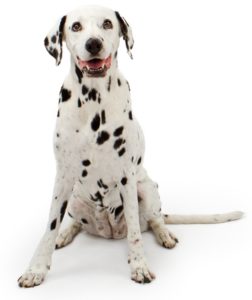 This immediately recognizable animal has already made a name for itself in the service industry.
This immediately recognizable animal has already made a name for itself in the service industry.
With endurance to spare, Dalmatians are up to busy days working with their human.
Athletic and cheerful, this is one dog that is ready for work as a therapy or service dog.
While you often see these dogs in public areas, they can become aggressive and need socialization training.
24. Border Collie
 Agile and energetic pooches in this breed shine in dog shows.
Agile and energetic pooches in this breed shine in dog shows.
Those traits, along with friendliness and a readiness to learn, make the Border Collie shine as a therapy dog as well.
This dog is intelligent and easy to train and does exceptionally well in working roles.
They are great for first-time owners and trainers.
These canines love people so much that they get depressed if left alone too much.
Like many breeds, they need training to be like other dogs.
25. Bloodhound
 Another breed that you may find surprising on this best therapy dogs breeds list is the Bloodhound
Another breed that you may find surprising on this best therapy dogs breeds list is the Bloodhound
These large dogs are excellent sniffers.
Because of that, these fur babies are great for medical service work.
They can sniff out chemical changes in the body of their person.
Dogs in this breed are sweet and mild-mannered.
They do great in situations where they are around crowds and strangers.
Bloodhounds are a little lazy.
They don’t have much energy and are prone to weight gain.
Honorable Mentions
The following breeds didn’t quite make our list but still make excellent therapy dogs:
- Maltese
- Miniature Poodle
- Irish Wolfhound
- American Staffordshire Terrier
Breeds to Reconsider As Therapy Dogs
Just like some breeds do better at being therapy dogs than others, some are worse than others.
You typically want to stay away from overly loyal and protective breeds, like Shar-Peis.
You also frequently don’t want to try training an independent breed that is rare to show affection to be a therapy dog.
Examples of this include the Pekingese, Kerry Blue Terrier, and Shiba Inu.
The Best Dog Breeds for Therapy Dogs
Reasons for Having a Service Dog or Therapy Dog
There are many benefits to getting a therapy dog, both for the abled and differently-abled bodies.
Assist the Visually Impaired
As previously mentioned, therapy dogs have been used for many years to assist the blind.
Even with the newer uses of therapy dogs, people still use pooches in the traditional role – as a seeing-eye dogs.
They can alert the handler if traffic is approaching too closely, lead them through doorways and divert them around obstacles.
Assist the Hearing Impaired
The best therapy dog breeds can also be used to assist the deaf.
With the new training, a dog has many jobs that it can do to assist those hard of hearing.
They can bring a ringing phone to its owner, alert when someone knocks on the door, and alert the owner if the smoke alarm (or any alarm) goes off.
Mental Illness
People with mental illnesses such as depression, anxiety, PTSD, and schizophrenia can now get a therapy dog as well.
For example, if the owner is having night terrors, the dog can wake them.
These types of therapy dogs can even be trained to move hands away from a person practicing self-harm (such as slapping).
A trained therapy dog is one of the best shoulders to cry on.
Humans with seizures or blood sugar disorders can also benefit from the help of a well-trained service dog.
While there is debate on whether a canine can actually detect a seizure, the other benefits they provide are not debatable.
These benefits include:
- bringing medication and bottled water when symptoms start
- pressing the owner’s life alert button when symptoms present
- alerting the owner of chemical changes, they can smell, such as low blood sugar
Many schools, nursing homes, hospitals, and even offices have programs where therapy dogs come in just to improve morale and calm people down.
The best therapy dog breeds list has some of the popular therapy dogs that can make their rounds to calm students with severe testing anxiety, bring smiles to bed-bound patients in nursing homes or hospitals, or provide a bit of boredom relief to children waiting on medical testing.
The Difference Between Therapy Dogs and Service Dogs
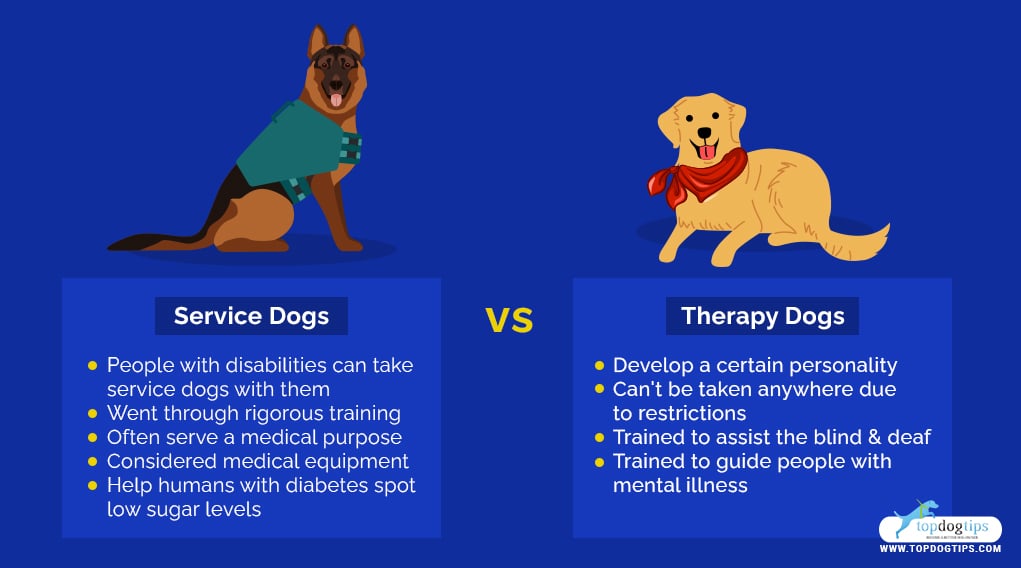
I know it's quite confusing in the beginning.
But service dogs and therapy dogs technically serve distinct purposes.
They also have different training and different legal accommodations.
Under the Americans with Disabilities Act, people with disabilities can take service dogs with them.
But it does not apply to emotional support dogs or therapy dogs.
Some businesses may also impose extra restrictions on them.
As for training, service dogs undergo rigorous preparation so they can complete a specific task that their human needs.
Still confused?
You can think of it this way.
Service dogs serve a specific medical purpose and are sometimes legally considered medical equipment.
They can be guide dogs, help humans with diabetes spot low sugar levels, or prevent people with PTSD from having flare-ups.
For example, with the reasons we have mentioned above, service dogs can assist the blind, deaf, and those with mental illness.
Therapy dogs, on the other hand, can give support to schools, hospitals, and other places where their calming presence is needed.
Where Do Emotional Support Dogs Fit In?
Legally, emotional support dogs are closer to therapy dogs than service dogs, but there are still some important differences.
I know. But hear me out.
Emotional support dogs provide support for a specific individual, while therapy dogs tend to help many people.
Most of the dogs that are good therapy dogs are also great as emotional support dogs.
There is also a lot of overlap with breeds good as service dogs, although most people still think of service dogs as only a handful of breeds.
INTERESTING READ: Emotional Support Animals Fraud Addressed
Where Can I Get Therapy Dogs?
Suppose you received your dog from a reputable agency, no matter the breed.
There is no need to worry about your new companion not being up to the physical or social activities that you enjoy.
The American Kennel Club offers a list of organized therapy dog groups on its website
You can reach out to one in your area if you're interested in finding a reputable breeder.
ALSO READ: How to Get a Service Dog for Anxiety or Depression & the Costs of It
Common Questions About the Best Therapy Dog Breeds
Even with all the information above, you may still have questions about therapy dog breeds and which pups are most likely to make great support dogs.
Much of the following information overlap with topics we already covered, but it’s organized more concisely to make it easier to absorb.
What breeds make the best emotional support dogs?
Any breed on our list could be a great emotional support dog.
Some of the best choices include beagles, Labrador retrievers, corgis, pugs, Pomeranians, Cavalier King Charles Spaniels, Golden Retrievers, and Yorkshire terriers.
What breed of dog is best for anxiety and depression?
Most of the dogs listed above as potential therapy dogs do well to support people with anxiety and depression.
Some of the best choices include French bulldogs, dachshunds, Labrador retrievers, golden retrievers, greyhounds, Yorkies, Saint Bernards, and Cocker Spaniels.
What dogs are used as therapy dogs?
Nearly any breed can be a therapy dog as long as the pooch has the proper training and personality.
That said, some of the most popular options include English Springer Spaniels, Mini Dachshunds, Cavalier King Charles Spaniels, Yorkshire Terriers, Bichon Frises, Lurchers, and Staffordshire Bull Terriers.
What is the best dog for a disabled person?
Labrador retrievers are the dog breeds most commonly trained to help people with disabilities.
German Shepherds, golden retrievers, standard poodles, and Pomeranians also make great service dogs with the proper training.
What is the No. 1 dog breed?
The most popular dog breed is the Labrador Retriever.
Other popular choices include French bulldogs, golden retrievers, and German Shepherds.
Best Therapy Dog Breeds: Take Your Pick!
So there you have it.
Our top 25 best therapy dog breeds, from the smallest to the largest canines.
We also included more information about therapy dogs: their benefits and how they differ from service and emotional support dogs.
With the proper training, combined with a great temperament and personality, any pup can be a therapy dog and help you or your community.
If you're interested to learn more about therapy dogs, check out our other blog posts below!
Related Articles:
- Therapy Dog Training – How to Get Your Dog Certified
- Therapy Dogs Reduce ADHD Symptoms in Kids, Study Shows
- Therapy Dogs May Help Autistic Children
- TOP #100: Therapy Dogs vs. Service Dogs: What's the Difference?
- Research Proves That Therapy Dogs Can Help Stressed-Out Students





